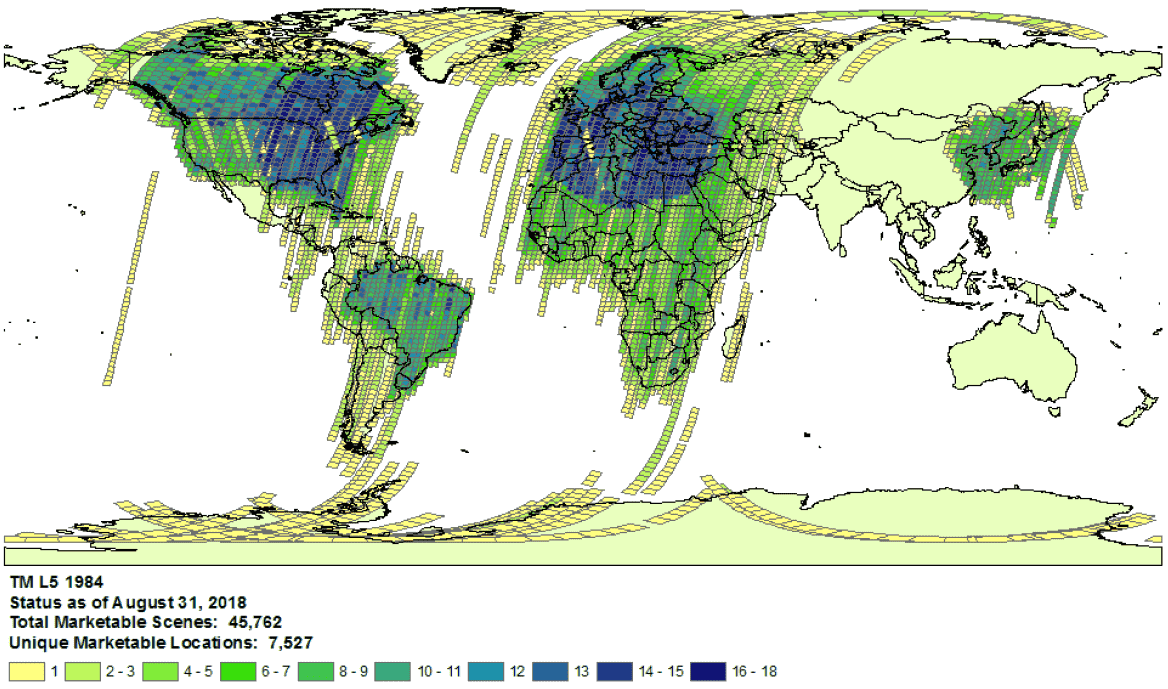このドキュメントの目的は、Earth Engine データカタログ(現在は Landsat、Sentinel、MODIS)にアセットが不足しているかどうかを判断することです。
以下の手順では、次のことを行う方法について説明します。
Earth Engine とプロバイダのカタログで利用可能なアセットを確認します。
不足しているアセットの確認を Earth Engine データチームに送信するために必要な情報を収集します。
一般的な考慮事項
処理レベル: 特定の処理レベルまたはプロダクトでは、一部の画像が使用できない場合があります。たとえば、画質の低い画像は最高レベルまで処理されない場合があります。
空間的および時間的なカバレッジ: 各データセットの定期的な頻度は保証されません。センサーのタスク、画像品質、アーカイブ管理のばらつきは、プロバイダのデータの可用性に影響する可能性があります。
 1984 年の Landsat 5 の収集範囲の例。
1984 年の Landsat 5 の収集範囲の例。
- プロバイダの選択: データは、データセットごとに選択したプロバイダから Earth Engine Data Catalog に取り込まれます。プロバイダが完全なミッション アーカイブを提供していない可能性があります。たとえば、Landsat データセットは USGS アーカイブから取り込まれますが、このアーカイブには特定の受信局からの画像が特定の期間欠落していることが知られています(詳細については、LGAC の取り組みをご覧ください)。
Landsat
Landsat データは、米国地質調査所(USGS)から取り込まれます。
対象の時間と地域の Landsat の撮影範囲の可用性を確認します。
Earth Engine で検索を実行して、対象の時間とエリアのすべてのアセットのリストを取得します。コード内でアセットが誤って除外されていないことを確認してください。以下にサンプル スクリプトを示します。適切な階層と処理レベルでコレクションをインポートしてください(Landsat コレクションの構造の詳細をご覧ください)。
USGS Earth Explorer カタログで、不足している可能性のあるアセットを探します(検索の実行とデータセットの選択の詳細な手順については、ヘルプガイドをご覧ください)。適切なプロダクトと処理レベルを比較していることを確認します(Landsat コレクションの構造をご覧ください)。地表反射率プロダクトは、処理レベルが L1TP の Landsat 画像に対してのみ生成されます。
プロバイダのプロダクト ID と、アセットが存在しないことを確認する Earth Engine コードエディタ スクリプトへのリンクを含むチケットを送信して、アセットがないことを示す詳細な証拠を共有します。
Sentinel
Sentinel データは Copernicus Dataspace サイトから取り込まれます。
対象の時間と地域で Sentinel の撮影範囲が利用可能であることを確認します(ミッションの詳細を参照)。
注: Sentinel-2 Level-2A プロダクトは、2018 年 3 月以降、ヨーロッパの地上セグメントでのみシステム的に生成されています。2018 年 12 月に、生成は全世界に拡大されました(詳細については、ESA ユーザーガイドをご覧ください)。最終的には、コレクション 1 の一部として再生成されます。
Earth Engine で検索を実行して、対象の時間とエリアのすべてのアセットのリストを取得します。コード内でアセットが誤って除外されていないことを確認してください。スクリプトの例を次に示します。正しい処理レベルでコレクションをインポートしてください。
Copernicus カタログで、不足している可能性のあるアセットを探します。
アセットがないことを示す詳細な証拠を共有するには、プロバイダのプロダクト ID と、アセットがないことを確認する Earth Engine コードエディタ スクリプトへのリンクを含むチケットを送信します。
MODIS
MODIS データは、Land Processes Distributed Active Archive Center(LP DAAC)から取り込まれます。
Earth Engine で検索を実行して、対象の時間とエリアのすべてのアセットのリストを取得します。コード内でアセットが誤って除外されていないことを確認してください。スクリプトの例を次に示します。目的の商品をインポートしていることを確認してください。
USGS データプールで、Earth Engine に追加されていない欠落しているアセットを探します。適切なフォルダに移動し、使用可能な最新のディレクトリを特定します。
「MOD」で始まるデータセットは「Terra MODIS」にあります。
「MYD」で始まるデータセットは「Aqua MODIS」にあります。
「MCD」で始まるデータセットは [Combined MODIS] にあります。
「VNP」で始まるデータセットは「S-NPP VIIRS」にあります。
アセットがないことを示す詳細な証拠を共有するには、プロバイダのプロダクト ID と、アセットがないことを確認する Earth Engine コードエディタ スクリプトへのリンクを含むチケットを送信します。
